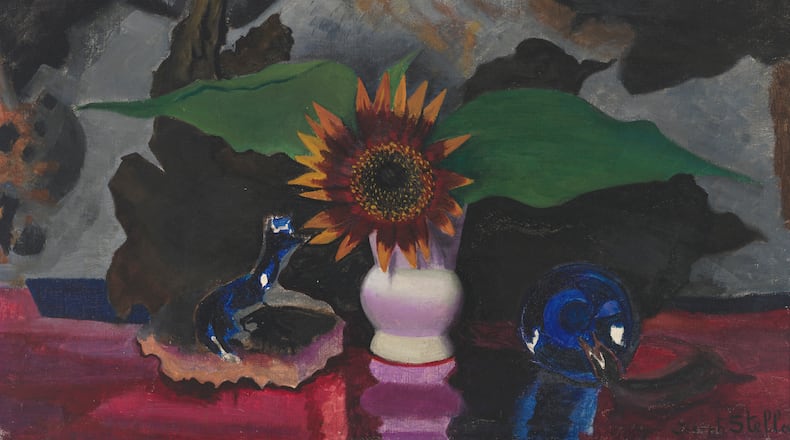In many ways “Joseph Stella: Visionary Nature,” opening Feb. 24 at the High Museum of Art, feels serendipitously timed. The pandemic alerted many of us to the beauty and fragility of nature right under our noses.
And modernist painter Stella’s mystical, deliciously trippy paintings of flowers, birds, trees and a natural world exploding with color and fecundity is a pleasant reminder of nature’s power to move and delight and connect us to something larger than ourselves.
“It was the right show at the right time in a way that we would never have been able to predict,” says Ellen Roberts, curator of American art at the Norton Museum of Art in West Palm Beach, the first venue for “Visionary Nature.”
Roberts first encountered Stella’s work while studying art history at Yale where “Brooklyn Bridge” (1919), a seminal work that exemplifies Stella’s groundbreaking modernism, hangs on the wall of the Yale University Art Gallery.
But that didn’t prepare her for his extraordinary visions of the natural world. “Visionary Nature” has proven illuminating even for art insiders like Roberts.
“This show introduced me to this whole other side of his production and how important it was for him,” she says.
Credit: handout
Credit: handout
A collaboration between Stephanie Mayer Heydt, the High Museum of Art’s curator of American Art, and Audrey Lewis, associate curator of the Brandywine River Museum of Art in Chadds Ford, Pennsylvania, “Visionary Nature” takes Stella’s celebration of nature as its crux. It is an unprecedented presentation of Stella’s work because it focuses on the lesser known — and sadly underappreciated — portraits of flora and fauna that exemplify his visionary approach.
The High Museum’s iteration of “Visionary Nature” is the most comprehensive among the three presenting venues, with more than 100 paintings and works on paper that also include industrial works that deify human achievement in contrast to Stella’s nature studies.
The last major retrospective of Stella’s work was in 1994 at the Whitney Museum of American Art. It focused on what Stella expert and Whitney curator Barbara Haskell calls “revolutionary” images of bridges, skyscrapers and the modern cityscape that made Stella’s reputation.
A true modernist thrilled by the skyscrapers and thrum of New York City, Stella emigrated from the small medieval town of Muro Lucano in Italy near Naples in 1896 at age 18. He created some of the most kinetic, abstract distillations of the sensory onslaught and architectural spectacle of modern life in his paintings “Brooklyn Bridge” (1919) and “Battle of Lights, Coney Island, Mardi Gras” (1914). As the first American painter to capture the industrial landscape, Stella’s paintings brought him recognition and renown.
Credit: Bridgeman Images
Credit: Bridgeman Images
But he died in 1946 in humble circumstances in the New York borough of Queens after having fallen out of fashion.
The same year he painted “Brooklyn Bridge” Stella also created “Tree of My Life.” That epic 84-by-76-inch rendering of a verdant landscape also visualized the extraordinary sweep of Stella’s life, from the pastoral calm of his native Muro Lucano to the exotic flora on view at the New York Botanical Garden. The focal point amid the painting’s visual cacophony, the tree stands in for Stella himself, growing and thriving in the soil of a new world.
Credit: Handout
Credit: Handout
People have described the experience of seeing “Tree of My Life” as disorienting, overwhelming, a painting you could get lost in.
“You do really have to see it in person,” says Roberts. “It just kind of takes your breath away. It seems on first glance to be realistic, you know, because it’s very detailed. But there’s a difference between detailed and realistic, so the individual details are realistic, but the way he puts them together is not realistic at all.”
In fact, a signature of Stella’s nature work is how fantastic it is, combining plants and animals that would never exist together into one deliriously stylized whole, a new imagined “visionary” landscape with shades of Hieronymus Bosch, folk art and religious icons. Imagination and realism deliriously collided, says Heydt, in an “off-center approach to how he saw the world.”
His paintings are hymns to the natural world’s abundance, exquisite cathedrals built to celebrate its bounty.
“Visionary Nature” originated before the pandemic in 2017 at art collector Barney Ebsworth’s Seattle home. Brandywine Director Thomas Padon saw “Tree of My Life” for the first time in person and came away from the experience awed, like many viewers.
“I was transfixed,” he told The New York Times.
Padon later traveled to the High where he saw Stella’s “Purissima” (1927), a supernatural vision of a Madonna flanked by two bowing white cranes against the Italian landscape. Flowers and animals genuflect at the scene like Balanchine ballerinas. In the distance Mount Vesuvius erupts, piercing the painting with an intertwined ancient and extraterrestrial mood, a uniquely Stella attitude curators Heydt and Lewis describe as “unexpectedly archaic but so inexplicably and satisfyingly modern.”
Credit: Handout
Credit: Handout
Heydt and Lewis decided a show centered on Stella’s phantasmagorical Edens was overdue. The idea for a collaborative Stella exhibition focusing on these psychedelic visions of nature was born. It travels to the Brandywine in June.
Painting nature was a transcendent, spiritual experience for Stella, who believed that an artist could access the healing power of nature through painting.
But from the work on view in “Visionary Nature,” his renderings suggest creation was also a form of play and delight. Works like “Zucchini Fantasy” of a green squash with a curved form that resembles a swan tips toward a Max Ernst-style surrealism. In Stella’s uniquely enchanted vision water lilies and lotuses sprout like a magical spring from color drenched landscapes, glowing with an otherworldly light.
Throughout his career, Stella would move between painting industry and nature. His multifaceted oeuvre showed the influence of a range of art movements from Italian futurism, fauvism and cubism to surrealism. The High exhibition includes a stunningly beautiful 1923-24 portrait of Stella’s friend surrealist Marcel Duchamp in silverpoint and oil on paper.
Credit: Handout
Credit: Handout
In her catalogue timelines for “Visionary Nature” Lewis points out that Stella (a gifted writer himself) was also inspired by writers Walt Whitman and Edgar Allen Poe. That pairing doesn’t seem odd when you consider Stella’s work — a rendering of divine nature activated by a lightning bolt of the fantastic.
“He found inspiration in everything from the smallest weed growing between the cracks of the sidewalk to majestic birds that he imagines in distant lands,” says Heydt.
For Lewis, Stella’s home in New York was not unlike our shared pandemic confinement, which “he escaped from through nature,” she says. “And all of his travels were to places where he could be close to nature.”
The work “resonates with present-day audiences because of the growing sense of the importance of nature and the threat to it in our own world,” she says.
“Nature was crucial to his ability to deal with the modern world,” says Roberts. Stella’s vivid, strange visions of squash and crotons, swans and goldfish, his tropical plants “are forms that are shocking and bizarre,” says Heydt.
“I would say, come in with your mind open.”
EVENT PREVIEW
“Joseph Stella: Visionary Nature.” Feb. 24-May 21. $16.50. High Museum of Art, 1280 Peachtree St. NE, Atlanta. 404-733-4444, www.high.org.
About the Author
The Latest
Featured






